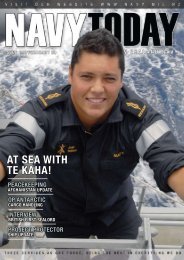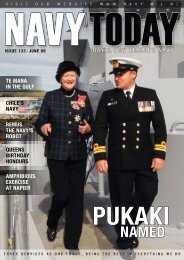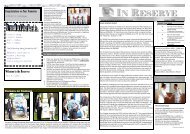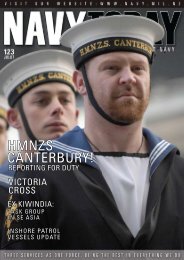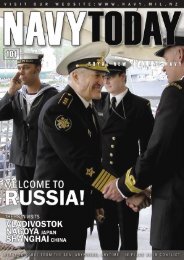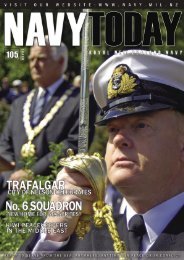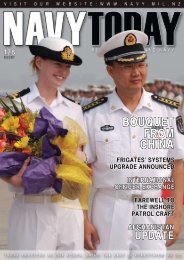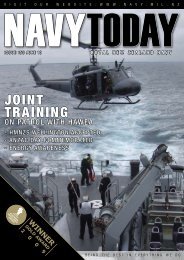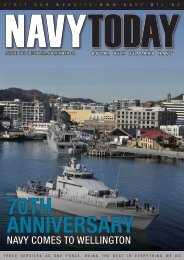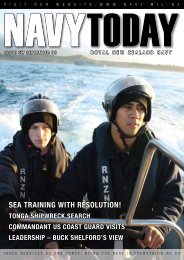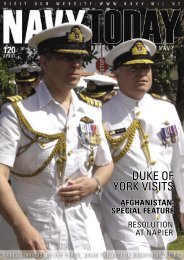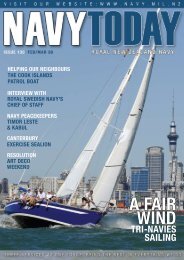Aug-Sep 2013, Issue 174 - Royal New Zealand Navy
Aug-Sep 2013, Issue 174 - Royal New Zealand Navy
Aug-Sep 2013, Issue 174 - Royal New Zealand Navy
Create successful ePaper yourself
Turn your PDF publications into a flip-book with our unique Google optimized e-Paper software.
Opposite page top: HMNZS WELLINGTON Med-Moored in SasaveleLagoon.Above: Preparing to detonate a bomb in Munda Lagoon.Middle left: Detonation! Middle right: In Munda Lagoon, CPODR DarrenMills (left seated) is supervising while ADR Te Rana Faulkner instructsLWTR Erin Smale and LT Dane Christophersen of HMNZS WELLINGTONin how to activate the remote firing device to set off Explosive Remnantsof War (ERW) during Op PUK 13.Bottom: Four Operational Diving Team personnel conducted anunderwater search in Munda Lagoon for WWII US Air Force-droppedbombs. They located two 2000lb and four 1000lb General PurposeBombs in this search.The EOD teams were supported by HMNZ Ships MANAWANUIand WELLINGTON, with the <strong>Navy</strong> Operational Diving Team’sCommander Trevor Leslie overseeing the entire operation.“All three NZDF Services have an excellent EOD capability and arealways on call to clear Explosive Ordnance domestically across<strong>New</strong> <strong>Zealand</strong> and further afield internationally,” says CDR Leslie.“For the <strong>Navy</strong>, EOD expertise is held by personnel from the divingtrade, who undertake domestic training at the Joint EOD School inTrentham and also an eight-month EOD course at Eglin Air forceBase, Florida, USA. Apart from diving duties, personnel from theODT also contribute to 1EOD Squadron through the conduct ofdomestic EOD throughout NZ.“Every two years we take this expertise overseas by leadingOperation PUKAURUA where we get to use our skills in Pacificcommunities where World War II explosives and other dangerousremnants of war are still present.“This year we took Operation PUKAURUA to Munda where amongother things we worked to clear a US ammunition dump onSasavele Island, made safe the island of Rendova and conductedwork in and around the town of Munda clearing ERW located closeto people’s homes.“Additionally we found eight unexploded 500 and 1000 poundbombs on the sea floor which were cleared by the dive teams.”The operation was made easier through interaction with the localresidents who assisted the EOD teams in the location of over2500 individual items of explosives and ammunition, includingdangerous white phosphorous shells, in areas close to wherepeople live.The operation’s first task on Sasavele Island was supported byWELLINGTON, which crossed the Munda Bar and anchored closeto the lagoon (see Med-Mooring, page 34).“Some of the charts we were working off for Munda were createdin the 1860s, so prior to crossing the bar and heading to Sasavelea <strong>Navy</strong> hydrographic team led by Petty Officer Thomas Nuttall didan advance survey,” says WELLINGTON’s Commanding Officer LTCDR Phil Rowe.“The team strapped transducers to the hull of a Zodiac and spenta couple of days creating charts so we knew where we couldgo. Amazingly the charts from the 1860s were still accurate andWELLINGTON was able to cross the Munda Bar. It was still quitenerve-wracking looking down and seeing the coral as we crossedthe bar, but because of the charts the team had created we knewOperation PUKAURUA9



